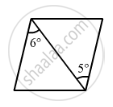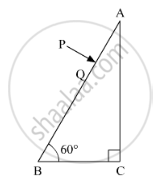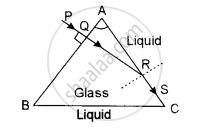Advertisements
Advertisements
प्रश्न
A thin prism of angle 6.0°, ω = 0.07 and μy = 1.50 is combined with another thin prism having ω = 0.08 and μy = 1.60. The combination produces no deviation in the mean ray. (a) Find the angle of the second prism. (b) Find the net angular dispersion produced by the combination when a beam of white light passes through it. (c) If the prisms are similarly directed, what will be the deviation in the mean ray? (d) Find the angular dispersion in the situation described in (c).
उत्तर
Given:-
For the first prism,
Angle of prism, A' = 6°
Angle of deviation, ω' = 0.07
Refractive index for yellow colour, μ'y = 1.50
For the second prism,
Angle of deviation, ω = 0.08
Refractive index for yellow colour, μy= 1.60
Let the angle of prism for the second prism be A.
The prism must be oppositely directed, as the combination produces no deviation in the mean ray.
(a) The deviation of the mean ray is zero.
Thus, we have:-
δy = (μy – 1)A – (μ'y – 1)A' = 0
∴ (1.60 – 1)A = (1.50 – 1)A'
`rArrA=(0.50xx6^o)/0.60=5^o`

(b) Net angular dispersion on passing a beam of white light:-
(μy – 1)ωA – (μy – 1)ω'A'
⇒ (1.60 – 1)(0.08)(5°) – (1.50 – 1)(0.07)(6°)
⇒ 0.24° – 0.21° = 0.03°

(c) For the prisms directed similarly, the net deviation in the mean ray is given by
δy = (μy – 1)A + (μy – 1)A'
= (1.60 – 1)5° + (1.50 – 1)6°
= 3° + 3° = 6°
(d) For the prisms directed similarly, angular dispersion is given by
δv – δr = (μy – 1)ωA – (μy – 1)ω'A'
= 0.24° + 0.21°
= 0.45°
APPEARS IN
संबंधित प्रश्न
A ray PQ incident normally on the refracting face BA is refracted in the prism BAC made of material of refractive index 1.5. Complete the path of ray through the prism. From which face will the ray emerge? Justify your answer.

What is the cause of dispersion of light
A ray of light incident normally on one face of a right isosceles prism is totally reflected, as shown in fig. What must be the minimum value of refractive index of glass? Give relevant calculations.

State any two difference between the primary rainbow and secondary rainbow
For any prism, prove that :
'n' or `mu = sin((A + delta_m)/2)/sin(A/2)`
where the terms have their usual meaning
Draw the ray diagram showing refraction of light through a glass prism and hence obtain the relation between the refractive index μ of the prism, angle of prism and angle of minimum deviation.
Describe an activity to show that the colours of white light splitted by a glass prism can be recombined to get white light by another identical glass prism. Also, draw a ray diagram to show the recombination of the spectrum of white light.
Can the dispersive power \[\omega = \frac{\mu_u - \mu_r}{\mu - 1}\] be negative? What is the sign of ω if a hollow prism is immersed into water?
A prism can produce a minimum deviation δ in a light beam. If three such prisms are combined, the minimum deviation that can be produced in this beam is _______________.
A certain material has refractive indices 1.56, 1.60 and 1.68 rfor red, yellow and violet lightespectively. (a) Calculate the dispersive power. (b) Find the angular dispersion produced by a thin prism of angle 6° made of this material.
A thin prism is made of a material having refractive indices 1.61 and 1.65 for red and violet light. The dispersive power of the material is 0.07. It is found that a beam of yellow light passing through the prism suffers a minimum deviation of 4.0° in favourable conditions. Calculate the angle of the prism.
Two prisms of identical geometrical shape are combined with their refracting angles oppositely directed. The materials of the prisms have refractive indices 1.52 and 1.62 for violet light. A violet ray is deviated by 1.0° when passes symmetrically through this combination. What is the angle of the prisms?
A ray of light is incident on a prism whose refractive index is 1.52 at an angle of 40°. If the angle of emergence is 60°, calculate the angle of the prism.
A narrow beam of monochromatic light, PQ, is incident normally on one face of an equiangular glass prism of refractive index 1.45. When the prism is immersed in a certain liquid, the ray makes a grazing emergence along the other face (See figure). Find the refractive index of this liquid. 
What is meant by the dispersive power of transparent material?
An equilateral glass prism has a refractive index 1.6 in the air. Calculate the angle of minimum deviation of the prism, when kept in a medium of refractive index `4sqrt(2)"/"5.`
Define angular dispersion.
For any prism, obtain a relation between the angle of the prism (A), the angle of minimum deviation (δm) and the refractive index of its material (μ or n).
